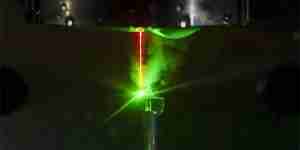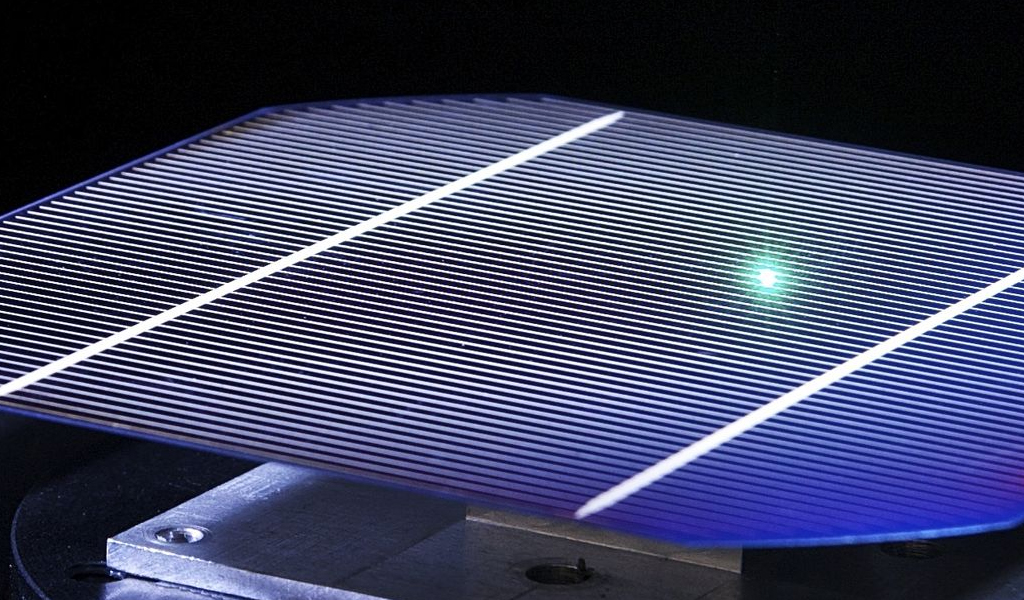Fiber laser cutting has become a game-changer in manufacturing, offering unmatched precision and efficiency. However, are you looking for ways to enhance your cutting process further? Fly Cutting, also known as “On the Fly” mode, can significantly boost your productivity when implemented with the right software and configurations.
With OPMT Laser’s expertise, you can achieve faster manufacturing cycles while maintaining high-quality results. In this article, we will uncover the mechanics of fly cutting in fiber laser machines, share valuable insights on its benefits, and guide you on how to implement it effectively. Get ready to elevate your production capabilities!
What Does Fly Cutting Mean?
Fly cutting is a laser cutting technique that significantly enhances operational efficiency by optimizing the cutting process. This method is particularly advantageous for tasks that require producing multiple identical shapes or holes quickly. By implementing fly cutting, businesses can reduce machine wear, material waste, and power consumption while achieving faster production times.
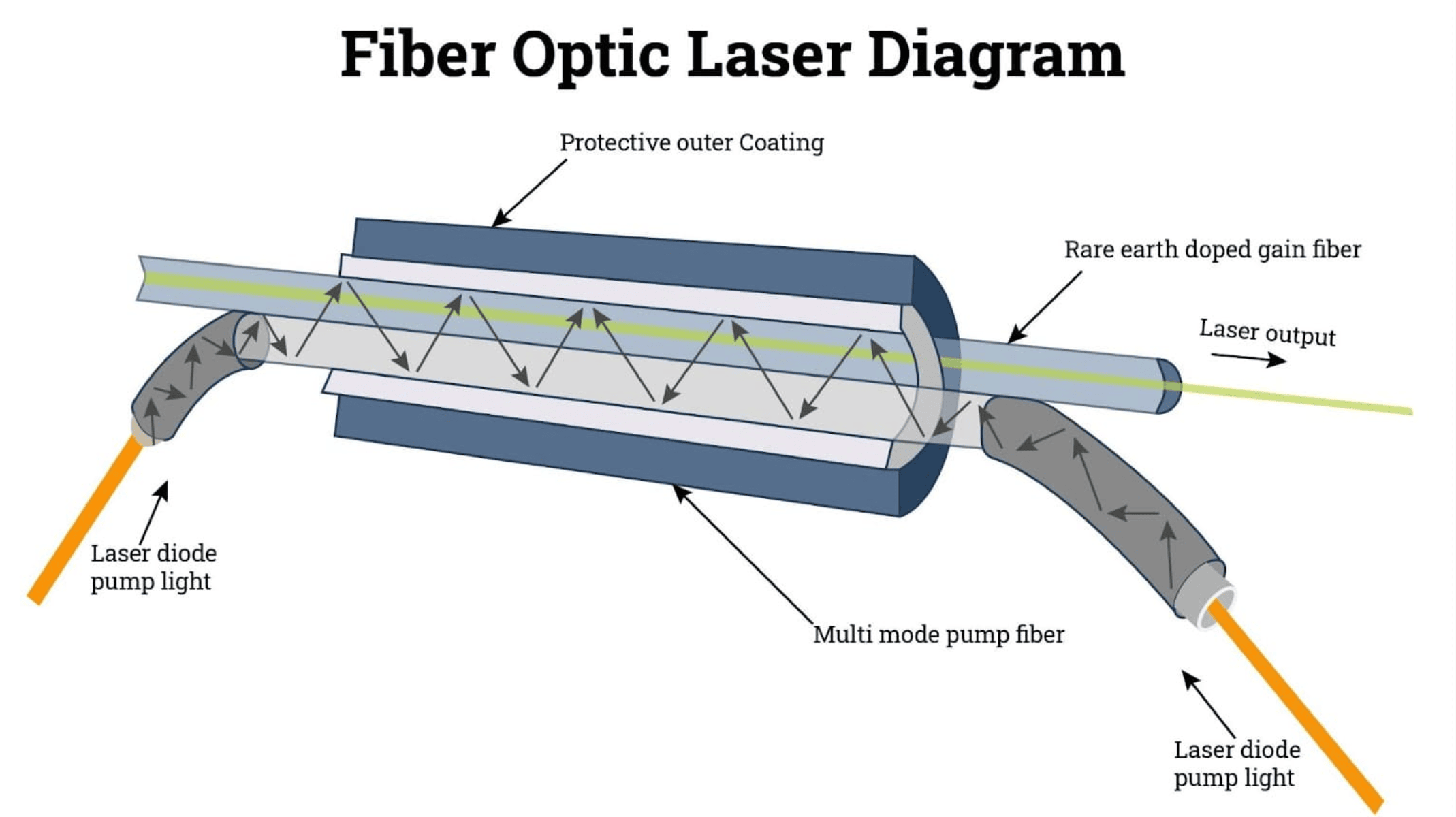
The Mechanics of Fly Cutting
At its core, fly cutting utilizes a path optimization technique. The laser head moves in a grid pattern, executing horizontal and vertical lines while activating and deactivating the laser at specific edges. This approach allows for multiple cuts to be made simultaneously, effectively minimizing the time spent on each operation.
When the laser head changes directions, it employs a tangential radius rather than sharp angles, further reducing both cutting time and wear on the equipment. Historically, laser heads moved along a single path until completing a cut; however, fly cutting revolutionizes this method by enabling more efficient task management.
Different Modes of Laser Cutting
Laser cutting technology has become a cornerstone in modern manufacturing, offering precision and efficiency across various applications. At OPMT Laser, we specialize in innovative CNC systems and laser processing solutions that enhance production capabilities. Understanding the various modes of laser cutting can help businesses select the most effective method for their specific needs.
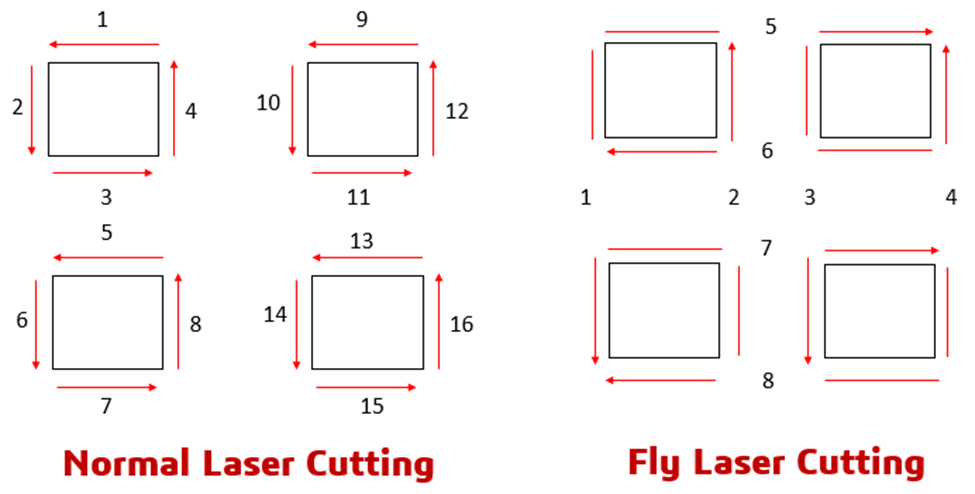
Common Cutting
Common cutting, often referred to as common line cutting (CLC), is an efficient technique where laser machines detect shared edges between multiple shapes. This approach allows the laser head to execute cuts along these common lines, significantly reducing material waste and processing time. By optimizing the cutting path, manufacturers can achieve intricate designs while maintaining high productivity levels. This method is particularly beneficial for large batches of similar parts, making it an ideal choice for industries focused on efficiency without sacrificing quality.
Fly Cutting Mode
Fly cutting, also known as grid cutting, is recognized for its speed and effectiveness. In this mode, the laser head divides identical shapes into a grid of horizontal and vertical lines. The laser activates at the cutting edge and deactivates in empty spaces, allowing for rapid execution of cuts with minimal movement. This method drastically reduces overall cutting time, making it perfect for high-volume production runs where speed is crucial. Manufacturers can leverage this technology to enhance throughput and meet tight deadlines.
Multi-Function Fiber Laser Cutting Machines
Multi-function fiber laser cutting machines represent a significant advancement in laser technology. These machines are capable of executing complex cuts on sheet metal with remarkable speed and accuracy. By utilizing high-power fiber laser technology combined with CNC systems, they can perform multiple tasks simultaneously, including engraving and marking. While this method enhances productivity, it is essential to consider its limitations regarding material thickness and specific design requirements. For example, OPMT Laser’s LP550V model exemplifies how advanced technology can streamline operations while delivering exceptional results.
Common Pierce Point
The common pierce point method involves the laser beam piercing a single point in the material to initiate the cutting process. After completing one shape, the laser head returns to this initial point to start cutting the next shape. This technique allows for deeper penetration with reduced energy consumption since it eliminates the need for multiple piercings across different shapes. It optimizes lead-ins and overall cutting time, making it a practical choice for intricate designs requiring precise cuts.
Normal Cutting
Normal cutting resembles traditional methods where each shape is cut individually. While this approach may seem less efficient than others, it remains valuable for machining complex shapes and dealing with thicker materials. It provides greater control over the cutting process, allowing operators to achieve high-quality finishes on demanding projects. This technique is particularly useful when precision is paramount, ensuring that even the most intricate designs are executed flawlessly.
By understanding these various modes of laser cutting, manufacturers can make informed decisions about which techniques best suit their production needs. OPMT Laser is dedicated to providing innovative solutions that leverage these advanced technologies to enhance productivity while maintaining exceptional quality standards. For further insights into our products and capabilities, explore our range of laser processing solutions.
Advantages of Fly Laser Cutting
Fly laser cutting is a cutting-edge technology that significantly enhances the efficiency and precision of laser processing. With its ability to optimize cutting paths, this method offers numerous benefits for manufacturers seeking to improve their production capabilities. OPMT Laser specializes in innovative CNC systems and laser processing solutions, making it an ideal partner for businesses looking to adopt this advanced technique.
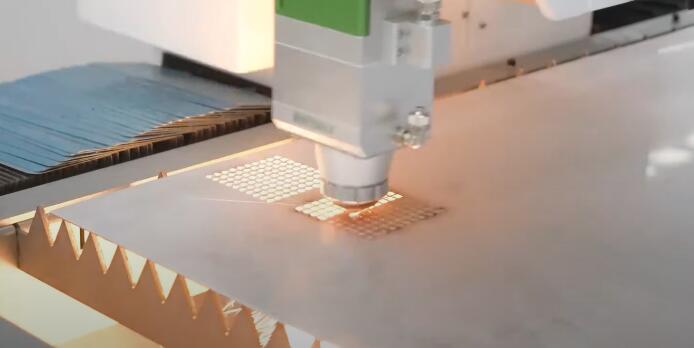
Shorter Lead Time
One of the primary advantages of fly laser cutting is its ability to reduce lead times. This method optimizes the cutting process by analyzing and determining the most efficient paths for the laser head, allowing for faster execution without compromising quality. Have you ever wondered how some manufacturers manage to deliver products so quickly? The secret often lies in technologies like fly laser cutting, which streamline operations and enhance productivity.
Improved Efficiency
Fly laser cutting enhances overall operational efficiency by minimizing unnecessary movements. By restricting the laser head’s motions to vertical, horizontal, and diagonal directions, energy consumption is significantly reduced. This efficiency not only leads to cost savings but also reduces wear on machinery, extending its lifespan. OPMT Laser’s systems are designed to maximize productivity while minimizing operational costs, ensuring that businesses can achieve more with less.
Less Slug Generation
Another significant benefit of fly laser cutting is the reduction in slug generation. This leads to lower material wastage and minimizes kerf at the cutting edges. By optimizing the movement of the laser head, manufacturers can achieve cleaner cuts and better material utilization. For example, businesses using fly laser technology can expect a substantial decrease in scrap material, translating into significant cost savings over time.
Longer Machine Life
The precise movements associated with fly laser cutting result in less mechanical wear and tear on equipment. This not only lowers maintenance costs but also extends the operational life of laser machines—a crucial factor for businesses that have invested heavily in such technology. By choosing OPMT Laser’s advanced solutions, companies can ensure they are maximizing their investment through enhanced durability and reliability.
Greater Profits
Implementing fly laser cutting technology can lead to substantial financial benefits. While initial investments in advanced software may deter some companies, the potential savings are significant. For instance, if a business generates $1 million annually, even a modest 4% improvement in efficiency could yield an additional $40,000 in profit. OPMT Laser provides tailored solutions that help businesses unlock these financial advantages while optimizing their production processes.
By leveraging the advantages of fly laser cutting, manufacturers can enhance their operations significantly. OPMT Laser is committed to providing innovative solutions that empower businesses to thrive in a competitive landscape. Explore our product offerings like Micro3D L530V or LP550V to see how we can help elevate your manufacturing capabilities.
Limitations of Fly Laser Cutting
Fly laser cutting is a powerful feature in modern CNC systems, yet it has specific limitations that users must consider. Understanding these constraints can significantly enhance operational efficiency and decision-making.
Material Thickness and Type
One of the primary limitations of fly laser cutting is its dependency on material thickness and type. This method is designed to maximize cutting efficiency in one direction, which can reduce the piercing time needed for a clean cut. However, reflective materials such as stainless steel and aluminum pose challenges due to their low laser absorption rates, making fly cutting less effective.
- Thickness Constraints: Generally, materials thicker than 1.5 mm are not suitable for this cutting technique. For optimal performance, it is recommended to work with materials that are 1 mm or thinner.
To improve cutting quality, settings should be adjusted to slower speeds, allowing the laser ample time to penetrate the material effectively. For example, using the OPMT Laser LP550V can help achieve better results with thinner materials.
Complex Shapes
While fly laser cutting excels at producing simple shapes with sharp edges, it struggles with more intricate designs. Complex geometries often require dividing shapes into horizontal and vertical cut lines, which can be inefficient and lead to poor results.
- Heat Management: When cutting complex shapes, heat tends to accumulate at certain edges, potentially compromising material integrity.
For intricate designs, alternative cutting methods may yield superior results. Utilizing products like the OPMT Laser Micro3D L570V can provide better handling of complex shapes without sacrificing quality.
Risk of Collision
Another significant risk associated with fly laser cutting is the potential for collisions between the slug and the laser head. This risk arises from factors such as improper cutting speed, inadequate path optimization, and insufficient assist gas pressure.
- Collision Prevention: To mitigate this risk, it is crucial to employ advanced CAM software capable of intelligent path optimization. This ensures that the cutting path is efficient and minimizes the likelihood of collisions.
By integrating solutions like OPMT Laser’s LightMut 750V, users can enhance their operational safety while maximizing productivity.
Softwares Used for Fly Laser Cutting
Fly laser cutting requires specialized software to ensure precision and efficiency in the cutting process. The right tools can significantly enhance the capabilities of laser cutting machines, allowing for intricate designs and optimized cutting paths. Here are some of the most effective software solutions available today.
Cypcut
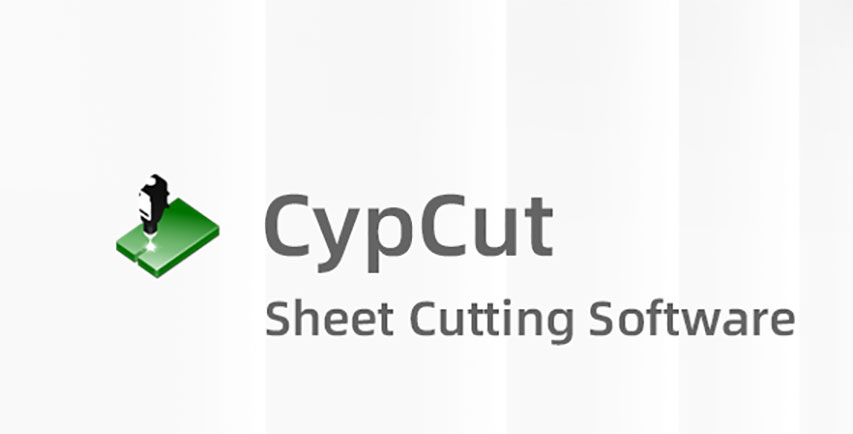
Cypcut is a comprehensive CAD/CAM software tailored for CNC machines, including laser cutters. It excels in optimizing drawings and configuring cutting settings, ensuring high precision in the cutting process. Notably, Cypcut features a built-in correction for “dual drive position” errors, which enhances accuracy. This software is ideal for manufacturers looking to streamline their operations while maintaining quality.
JetCAM

JetCAM stands out as a powerful option for generating complex G-codes with remarkable accuracy. Its user-friendly interface allows operators to efficiently create nesting programs, which are crucial for minimizing material waste. By automating many processes, JetCAM significantly boosts productivity, making it suitable for both small workshops and large-scale production environments.
Cut Assist v2.0
Cut Assist v2.0, developed by ANCA Motion, offers an intuitive interface designed specifically for machine operators. This software optimizes the fly-cutting procedure by allowing users to adjust critical parameters such as laser width, cutting speed, and switching frequency. With its interactive design, even those with limited experience can achieve high-quality results quickly.
LightBurn

LightBurn is a versatile solution compatible with various operating systems, including Windows, macOS, and Linux. It supports multiple graphic formats and provides essential tools for creating designs tailored for laser cutting. LightBurn is particularly popular among hobbyists and small businesses due to its affordability and comprehensive feature set.
Fusion 360
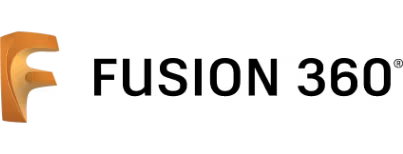
Fusion 360 integrates CAD, CAM, and CAE functionalities into one platform, making it an excellent choice for those requiring robust design capabilities alongside manufacturing tools. It allows users to create detailed 3D models and generate necessary G-code directly within the application, simplifying workflows and enhancing productivity.
Inkscape
Inkscape serves as a free vector graphics editor widely used for designing graphics intended for laser cutting. While it may lack some advanced features of paid software, it supports various file formats and provides essential tools for creating precise vector paths required for effective laser cutting.
TurboCAD
TurboCAD is renowned for its powerful design capabilities tailored specifically for laser engraving and cutting applications. It includes features like the Overkill tool that cleans up vector graphics by removing unnecessary points, ensuring smoother cuts.
LaserWeb
LaserWeb is an open-source platform that provides control over laser cutters based on user designs. It supports multiple file formats and facilitates collaborative project management, making it an excellent choice for educational settings or community workshops.
OPMT Laser offers innovative CNC systems and laser processing solutions that integrate seamlessly with these software options. By choosing OPMT Laser products like the LP550V or LightMut 750V, users can maximize their efficiency in fly laser cutting applications while leveraging advanced software capabilities.
These software solutions are essential tools in the fly laser cutting industry, enhancing productivity and precision while allowing manufacturers to execute complex designs with ease.
Conclusion
Fiber lasers are revolutionizing manufacturing with their unmatched precision and efficiency, particularly when paired with advanced programming techniques like Fly Cutting. This innovative method can significantly reduce lead times and resource consumption, making it an attractive option for various industries. However, it’s essential to be aware of its limitations to avoid potential setbacks.
At OPMT Laser, we offer cutting-edge laser solutions designed to enhance your production capabilities. Our fiber laser machines not only deliver superior performance but also enable intricate designs with shorter turnaround times. With our competitive pricing and exceptional after-sales support, you can trust that your investment will yield long-lasting benefits.
Did you know that implementing efficient cutting technologies can boost profits by 4% or more? If you’re ready to elevate your operations, explore OPMT Laser’s offerings today and discover how we can help you achieve remarkable results in your manufacturing processes!
Disclaimer
This content is compiled by OPMT Laser based on publicly available information for reference only; mentions of third-party brands and products are for objective comparison and do not imply any commercial association or endorsement.

